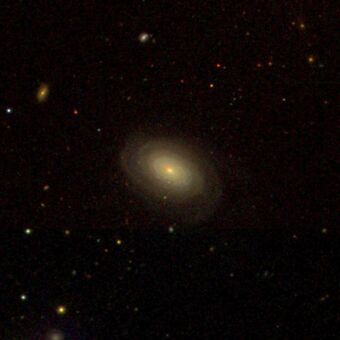Astronomy:NGC 223
From HandWiki
Short description: Spiral galaxy in the constellation Cetus
| NGC 223 | |
|---|---|
 SDSS image of NGC 223 | |
| Observation data (J2000 epoch) | |
| Constellation | Cetus |
| Right ascension | 00h 42m 15.9s[1] |
| Declination | +00° 50′ 44″[1] |
| Redshift | 0.017772[1] |
| Distance | 238 Mly[2] |
| Apparent magnitude (V) | 14.0g[1] |
| Characteristics | |
| Type | SB0[1] |
| Apparent size (V) | 0.42' × 0.29'[1] |
| Other designations | |
| IC 44, UGC 00450, CGCG 383-074, MCG +00-02-129, 2MASX J00421585+0050432, IRAS F00397+0034, PGC 2527.[1] | |
NGC 223 is a spiral galaxy located approximately 238 million light-years from Earth.[2] It is located in the constellation Cetus. It was discovered on January 5, 1853, by George Bond.[3]
See also
References
- ↑ Jump up to: 1.0 1.1 1.2 1.3 1.4 1.5 1.6 "NASA/IPAC Extragalactic Database". Results for NGC 0223. http://ned.ipac.caltech.edu/cgi-bin/objsearch?objname=NGC+223&extend=no&hconst=73&omegam=0.27&omegav=0.73&corr_z=1&out_csys=Equatorial&out_equinox=J2000.0&obj_sort=RA+or+Longitude&of=pre_text&zv_breaker=30000.0&list_limit=5&img_stamp=YES.
- ↑ Jump up to: 2.0 2.1 An object's distance from Earth can be determined using Hubble's law: v=Ho is Hubble's constant (70±5 (km/s)/Mpc). The relative uncertainty Δd/d divided by the distance is equal to the sum of the relative uncertainties of the velocity and v=Ho
- ↑ "New General Catalog Objects: NGC 200 - 249". Cseligman. http://cseligman.com/text/atlas/ngc2.htm#223.
External links
- NGC 223 on WikiSky: DSS2, SDSS, GALEX, IRAS, Hydrogen α, X-Ray, Astrophoto, Sky Map, Articles and images
- SEDS
Coordinates: ![]() 00h 42m 15.9s, 00° 50′ 44″
00h 42m 15.9s, 00° 50′ 44″
 |

